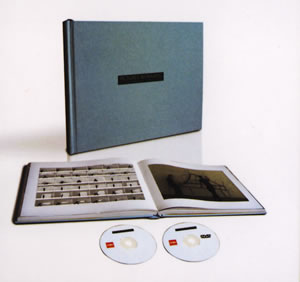Other Links
Editorial Board
- Editor - Bill Kenny
- Founder - Len Mullenger
Google Site Search
SEEN AND HEARD SPECIAL FEATURE REPORT
Pictures Reframed acts as the epicenter of Leif Ove Andsnes’s 2009-10 recital season. The highly acclaimed Norwegian pianist and the no less successful South African graphic artist Robin Rhode (1976) have been developing this project, supported by Norway’s Statoil, a leading company in international natural gas and oil production and one of the large operators on the Norwegian Continental Shelf.
Statoil is also the company that provides substantial financial means for individuals with the ability to think outside the box and to make the impossible possible. People with the skills and determination to achieve remarkable results. They hold the key to a successful future, not just for a company like Statoil but for society as a whole. Statoil calls them the 'heroes of tomorrow'. These are, in short, Statol's motifs for its extended scholarship progam. Back in 1990, Leif Ove Andsnes (1970) was the first artist to get a Statoil sponsorship and it was again Statoil generously underwriting the Pictures Reframed project and acting as its commissioning sponsor.
Andsnes is arguably one of the few highest ranking artist of the prestigious London based record label EMI Classics No wonder that EMI jumped into this challenging project by producing and marketing a CD and DVD, handsomely packed in a deluxe book (all copies of this edition are individually numbered), containing Robin Rhode’s highly impressive art work for this project, in full-color (a single audio CD is also available)..
The heart of the project
Modest Petrovich Mussorgsky’s ((1839-1881) piano suite Pictures at an Exhibition, based on paintings by Viktor Alexandrovich Hartmann (1834-1873), is at the heart of this project. Andsnes performs the music on the rostrum, with Rhode’s video graphics projected at the same time onto a specially designed stage set. Rhode’s basic setting comprises five graphically printed large panels orbiting the stage, evoking a room within an exhibition. The central video projection itself acts as an optic ‘window’ absorbing the eye of the spectators. Rhode was strongly inspired by the Bauhaus artist and teacher Herbert Bayer’s famous diagram from 1935 depicting the eye’s perception of three-dimensional space; Bayer’s illustration shows a figure surrounded by geometric planes and their awareness of a 360 degree field of vision.
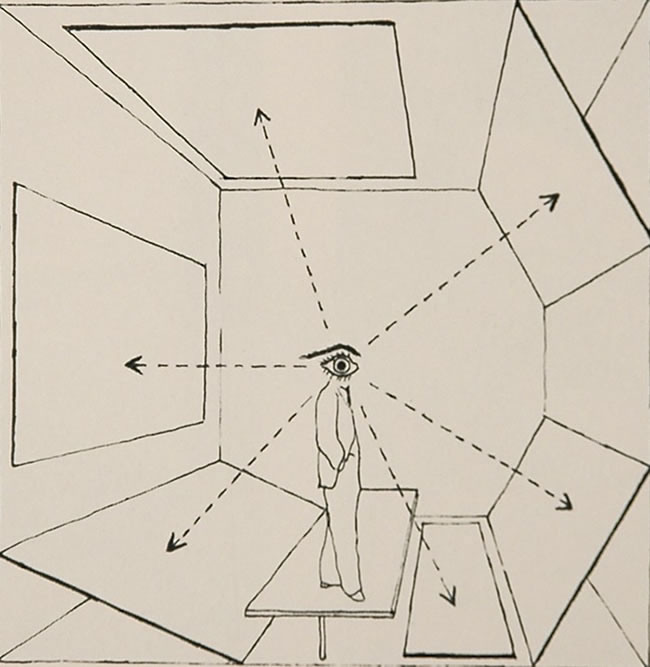
Diagram extended field of vision (Herbert Bayer, 1935), Visual Communication,
Architecture, Painting, New York, Reinhold publishing corporation, 1967
The painted panels show ‘activated’ spray painted forms (many taken from
stencils used in the accompanied animations); as if they are moving through
space across the panels, unconfined by their constraints, creating a perception
of the stage, shifting, rotating, along with the musical and visual narratives.
This graphic installation remains the fixed stage set within the ever-moving
images and the music.
One of the main themes in Rhode’s art work is childhood. In his new film Kid
Candle Rhodes has captured ideas about childhood through the simplicity of a
single stationary camera, with a white wall as the stage, and a basic line
drawing. Rhode maintains that any situation or any struggle can be met with
triumph and joy and that the imagination can make fantasy reality.
Rhode: “The idea of using aerosol spray paint to make graffiti on a range of
surfaces, mainly walls and outdoors, is how my spray paintings developed, but my
‘Spray Painting’ film shows the result of my having the surface of a white
canvas. Besides combining aspects of traditional painting fused with processes
of street art (of form of expression in which I seek constant aesthetic
alignment and always have), the nature of my Spray Painting film leans towards
ideas that embody early photographic processes.”
“In terms of photography the ‘Spray Paintings’ relate to the idea of natural or
artificial light affecting a flat surface, usually photographic paper coated in
emulsion, with a positive form placed directly onto the paper surface. The
positive form I used to make the ‘Spray Paintings’ is the cardboard stencil. The
spray paint enters the negative space and functions like rays of light almost,
which begin to affect the nature of the given surface and create strong negative
and positive shapes – forms. My painting process involves the overlay of forms,
both negative and positive geometric cutouts, in order to create a dynamic
abstract surface that starts to animate on the retina of the eye. I’m interested
in this idea of activating things, activating the space and animating the eye.”
Rhode has emerged as one of the most exciting young artists avoiding the
limitations of working in one single artistic realm. He regularly uses drawing,
video and photography techniques to create multi-disciplinary pieces of art. His
graphics often contains physical human interactions with the images he creates.
He draws commonplace objects on walls or on the floor, then takes photographs or
films. By using these objects he shapes a sequence of events, a fluid action or
interaction. His work is either convincing or controversial because of its
ability to straddle both these opposite worlds: the real and the imaginary.
Rhode sees the world as a huge sheet of paper, with each and every spot as a
potential framework for his art.
Rhode's work is exhibited at a.o. the Museum of Modern Art (MoMA) Solomon R.
Guggenheim Museum and Perry Rubenstein Gallery in New York, Goetz Collection in
Munich, Johannesburg Art Gallery and FRAC Champagne-Ardenne in Reims.
Tiny but meaningful fragments...
I met Leif Ove Andsnes and Robin Rhode at the Dominican hotel in Brussels, where
we all stayed for the European premiere of the project. Leif and Robin were
fully engaged with all the preparations for this highly important venture, but
they found the time to respond to a few questions. To start with, did Rhode’s
artistic concept come close to what Mussorgsky obviously intended with drafting
his fifteen tableaux (including five 'promenades') that make up the Pictures at
an Exhibition piano suite? Did he want to 'follow' the music? Rhode’s response
could hardly be misinterpreted: “It has never been my intention to create
anything like that. I hope that the audience may just find tiny but meaningful
fragments, important moments of visual pleasure, without feeling obliged to
think about all of this; and surely not in the sense of thinking in structures.
At the same time it must be said that contemporary music really offers much more
opportunities to experiment, opposite classical music which is much more
defined.“
What about allusions? Rhode’s ‘graphic’ vision on the first three Promenades of
Mussorgsky’s masterpiece goes back to the composer’s youth, but also with his
connection to his military rank, a ‘Kadet’ in the Russian army. By his
animation, Rhode characterizes youth in general terms on the path of self
discovery, with feet firmly grounded onto cubes that truncate as they shift
through space: “The geometrics highlight the struggle to define the individual’s
own unique position in the world outside; as the cube transcends time its form
starts to change as if the ‘Kadet’ has placed the exerting force onto it. The
character remains physically suspended, his feet never touching the ground, thus
rejecting reality.”
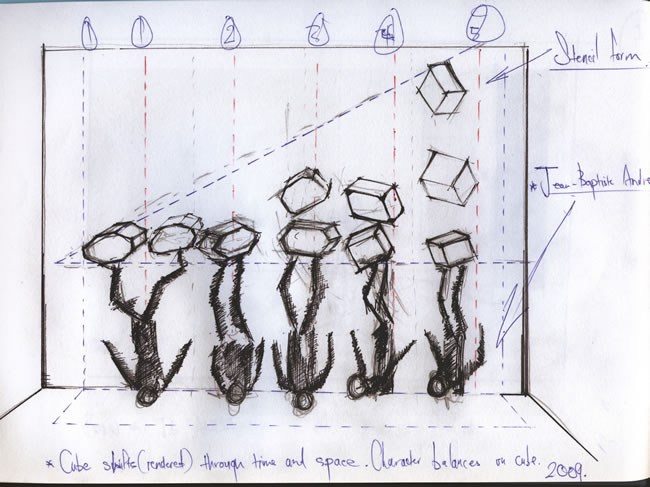
© Robin Rhode: Sketch for Promenade 1. Kadet (part 1). 2009
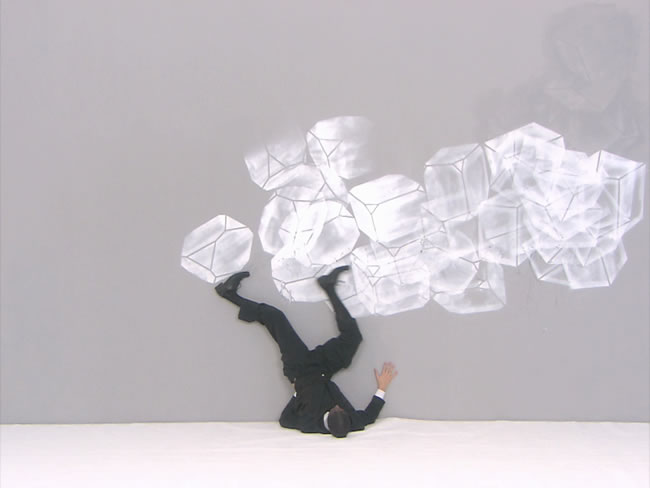
© Robin Rhode: Promenade 1. 'Kadet' (part 1) (video frame, excerpt)
At breakfast, Rhode’s emphasized in his fluent South African accent that he had
thoroughly done his homework after Andsnes had finally asked him to participate.
He did not know Mussorgsky, let alone the Pictures and it took him some time
(much too long as far as the impatient Norwegian pianist was concerned!) to get
into it, and to liaise with Hartmann’s paintings as well. It was not only a
matter of understanding it all, what it was all about, but also really getting
into it, by grasping each and every detai of it. The main question was of
course: where did this almost violent music come from?
It was the early death of his friend, the architect and designer Viktor
Hartmann, which spurred Mussorgsky to compose his Pictures at an Exhibition,
after he had attended an exhibition of Hartmann’s work to commemorate his
artistic life. Hartmann’s pictures all have titles and Mussorgsky must have been
quite impressed if not overwhelmed by their presentation at the gallery because
we can clearly hear how the composer meticulously depicted these in sound in
such a fashion that we can almost see them through our mind’s eye. There is no
question about it: this is in each and every sense supreme program music which
is quite strongly rooted in Romantic Russia of the second half of the nineteenth
century.
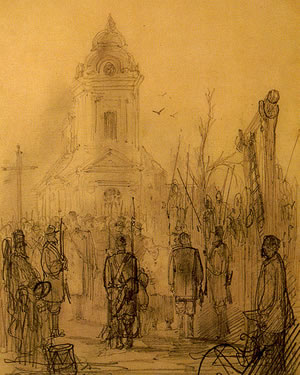
Viktor Hartmann's painting associated with 'Bydlo'
Mussorgsky’s music withstood the test of time, but Hartmann’s paintings did not.
As it so often happens, history has been far from kind to Hartmann’s art, and
most of his work is lost, as are most of his paintings. Nowadays we can only
‘view’ Hartmann’s paintings through Mussorgsky’s music. And how realistic that
music is! We can almost see that dragging Polish cart on enormous wheels as
being drawn by those oxen (in Bydlo), and we can hear the vividly ‘painted’
quite busy market scene at Limoges with a group of French women quarreling and
gossiping. As we can shiver when faced with the stacked skulls in those dismal
Paris catacombs. The Great Gate of Kiev is depicted in the awe-inspiring great
finale, in true Russian romantic fashion, building one arresting climax after
the other.
A compelling (ad)venture
It may be argued that this very strong music does not need any visual aids. It
has been done without them for years, as part of a great and well established
tradition. Why should that be changed? And especially when the Pictures are in
the hands of one of today´s greatest pianists. Andsnes has been referred to as
an “eminently sensual musician, an artist capable of grace and
introspection” (Financial Times) whereas BBC Music Magazine commented on how hard
it was to over-praise the vitality and distinction of this princely pianist; an
aristocrat among his colleagues who has the gift of uncovering new depths
without any loss of spontaneity or the slightest trace of artifice. The New York
Times marked Andsnes as a pianist of magisterial elegance, power and insight in
repertory including Mozart, Schubert, Prokofiev and Bartók (but nothing about
his incredible ability to performing contemporary music…).
Rightly so, not one word too many, it is all spot on. Andsnes is indeed one of
those rare miracles of the present musical world, who demonstrates his almost
boundless versatility time after time, no matter whether he lays Schumann,
Rachmaninov, Dalbavie, Sørensen, or Kurtág. His playing range goes back to Bach
and could end up with a work that was composed just a few months ago.
As an exclusive EMI Classics artist, Andsnes has recorded over 30 discs, been
nominated for seven Grammies and awarded many international prizes including
four Gramophone Awards to date. He received Norway’s most distinguished honor,
Commander of the Royal Norwegian Order of St. Olav. In 2007, he was awarded the
prestigious Peer Gynt Prize by members of parliament to honor prominent
Norwegians for their achievements in politics, sports, and culture. Andsnes is a
professor at the National Academy of Music in Oslo, a visiting professor at the
Royal Music Conservatory in Copenhagen and a member of the Royal Swedish Academy
of Music.
Why would such an artist want to meet a challenge like this? Did Andsnes want to
focus on attracting more young people to his concerts, those who are maybe going
to art galleries, who are interested in contemporary art, but who don't think
that classical music is fashionable? He had been thinking for years about how he
could merge with another art form. Sitting with friends in a New York café the
idea came up to do something with film. He discussed it with the management of
Lincoln Center, where they put him in touch with Laurence Dreyfus in Paris, an
expert in the video art domain and who showed him the work of a variety of
artists. It was here, where Robin Rhode’s art work generated the synergy Andsnes
needed. Andsnes: “I found his work really very, very special. There was a lot of
musicality and poetry in it.” But at that time Rhode’s name did not ring any
bells for Andsnes, as they did not for Rhode when he met Andsnes in Munich, in
2007, at Rhode’s first European exhibition. For Rhode, a hip hop fanatic,
classical music was unknown territory, a blank spot in his very busy life. But
after the meeting with Andsnes he got electrified and watched YouTube videos of
him over and over again. As far as Rhode was concerned this was all very
fascinating stuff from another world. And he definitely wanted to take part in
that.
And Andsnes? Rhode appeared to be the creative artist to canalize his eagerness
to do it all different this time, after nearly two decades of traveling around
the world and giving concerts and recitals here, there and everywhere. Somehow,
he saw the realization of his idea, incubated over a rather long period of time,
not to commission new music but to put forward an additional dimension to his
music making, albeit as a kind of experiment. Further along the road it did not
take much pondering to arrive at Mussorgsky’s Pictures at an Exhibition, a work
that was so much inspired by another art form, painting.
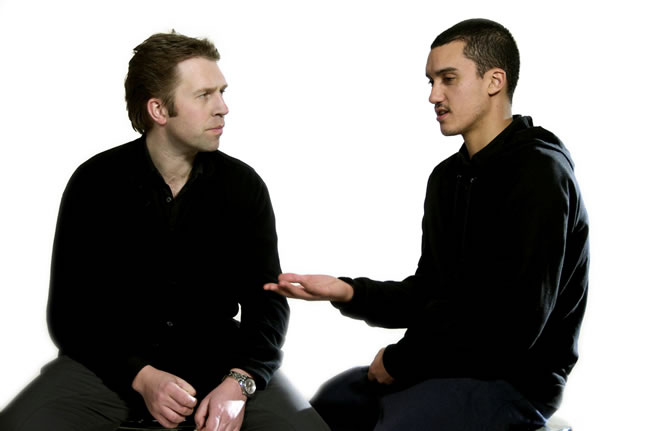
Leif Ove Andsnes and Robin Rhode © NRK photographer Tore Zakariassen
I asked Andsnes why he felt so compelled to explore the possibilities of visual
aid to his concerts. “It has just to do with curiosity. I mean to try other ways
of doing a concert. Of course, this is a very radical way of doing it, but it
has made me think a lot about how a concert works. For example, apart from the
movie and the visions of Robin, the fact that this feels like one journey. That
the lighting is very conscious, as the building of the promenades is, the fact
that we can bridge the different pieces by some visuals. Already that makes the
audience think ‘Oh, there is no normal applause, what should we think or do
now,’ and then they’re listening in a way. This is also what I feel in my
performances, that the audience is confronted with a new kind of concept and
already that is worth something to me. Then, if the movie works or not, that is
extremely individual. That is what I know from anybody we’ve been talking with
about this project. But I must agree with you that the music doesn’t need this,
and that I don’t need it either!”
“I always knew that it would be a controversial project, and a challenging, a
difficult one, because we are not used to listen and to watch so intensely at
the same time during a concert. And I admit that when you do that, at one time
the visual is in the foreground, and another time the music is. It is difficult
to incorporate both on the same level, at the same time. But our hope was that
this creates something new and that the two, the visual and the aural, meet at
certain moments, and make it all a worthwhile venture.”
Can this be seen and heard as a stand-alone project? “Definitely so, or at least
I have some limitations to take into account. But I might one day take up your
idea to work out a new project on basis of Iberia by Albéniz! This is very
evocative and colorful music indeed, deeply rooted in Spanish folklore. The
obvious reason for opting for the Mussorgsky piece is that it really comes from
paintings, from vision, but this is not the main thing. It is more important
that it comprises fifteen short movements that, I think, would make it an
interesting piece for visual artists to probe different techniques. A long piece
would make this much more difficult, if not impossible. Because then you are
very easily lost, asking yourself whether you should concentrate on the film, or
on the music. Then, it is such a strong piece from start to finish, so visual
and physical that the music could hopefully survive in combination with video,
although this is a very powerful medium, absorbing a lot of attention. Those two
reasons have been more important to me than the fact that this music comes from
strong impressions that were ignited by those Hartmann paintings.”
“This Pictures Reframed took a lot of time and effort, and not to say money, and
so far we’re faced with rather mixed feelings, more or less equally to yours,
but the challenge was to create the framework that brought Hartmann’s paintings
through Mussorgsky’s music back to the public.”
Didn't he think that it is in fact the original piano version which really
brings the Pictures at an Exhibition back to the public? Despite the supreme
beauty of Maurice Ravel’s orchestration, quite evidently and astoundingly
revealing unsurpassed imagination, it does not have the roughness, the edginess
and the sheer emotional power we find in the much less cultivated piano work
itself. Frankly, at times we might not need anything more than just that. “I
fully agree here. Actually, do you know the Stokowski version of the work? To
me, that one offers the roughness you talk about. But I also realize that he
couldn’t have done it without Ravel in the first place. Because it was Ravel who
showed the model for orchestrating the piece in the first place. He was a real
genius in orchestration, but I agree that it sounds sophisticated, at least
compared to the original piano version.”
Talking about orchestration, there has always been the tendency to interfere
with Mussorgsky’s original conceptions, by trying to ‘improve’ his
orchestration, or by simply adding new instrumental colors or even notes. As
Andsnes did in the Pictures, by doubling octaves and adding specific
ornamentations. It is not really a transformation of musical ideas but it is as
if those arrangements affirm that Mussorgsky was a great but clumsy composer.
“Yes, but I feel that it makes his music even stronger, and I also believe that
this is what finally should count. Mussorgsky’s piano suite is more or less in a
sketch-like shape, and he was indeed less capable to write for the piano,
although his immense vision about the piece itself stands beyond anything else.
In addition, we should be aware that in many works of art, and especially in
music, in autographs, manuscript copies or first prints, there are those
inevitable mistakes that need to be addressed as well. It’s not just a matter of
black or white. But apart from all that I can tell you that this is the only
piece where I take certain liberties with Mussorgsky’s score. By the way, this
makes it also so fascinating to do this project.”
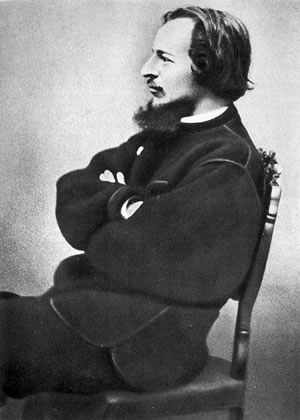
Viktor Hartmann (1834-1873)
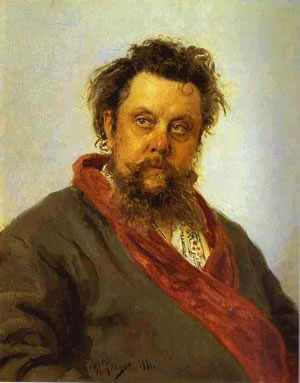
Modest Petrovich Mussorgsky (1839-1881)
shortly before his death (portrait by Ilya Repin)
Robin adds: “I was highly interested in this composition, and particularly from
the perspective that it was based on sketches. I studied those paintings which
evoked Mussorgsky’s musical inspiration and found that they all are open to many
different interpretations, and that there is a certain incompleteness to this. I
definitely needed Leif Ove’s to guide me through this music, to get a better
understanding of it. What I had in mind needed to fit with his determination to
play the music exactly as he wanted it to be played, and that the film had to be
adapted to that, not as a kind of give and take.”
Then, where did they both end up? Andsnes: “To be honest, I found it hard for me
to think in the way of creation as Robin can do so easily. We really had to know
each other quite well before finding a mutual creative direction. Of course, I
had to realize that Robin’s creative approach to the music would mean a quite
different concept that would be his own, and sometimes even opposite the music’s
own tempo and rhythm; a sharply contrasting flux we also find in this incredible
music. I’m also convinced - and this really doesn't bother me at all - that the
visual elements frequently interfere with listening to the music, when at other
times it may be the music that dominates.”
How must it be to play such a work that many times, taking it with you all
around the globe? “It’s hard but it’s also rewarding. It gives the freedom after
a while. Of course, I know the entire recital program by heart, but there is a
lot to concentrate on. But after the first six performance in the US in the last
two weeks I got much more experience about how the whole evening feels. I could
– in a way – free myself, not only from Robin’s graphics and what they are all
about, but also from the scores in my mind. You know, I don’t even look at the
video at all, I don’t want that. I solely concentrate on the music, and after a
while I can give a bigger breath, so to speak The first time you play a piece
you have to concentrate on so many details and you have so many conscious
thoughts about that. After some time it is more in a higher perspective, it
breathes better. That you can see it more from a bird’s perspective, overlooking
the entire landscape underneath. And still you hope you have all the details in
that and that it sounds fresh and kinetic.”
I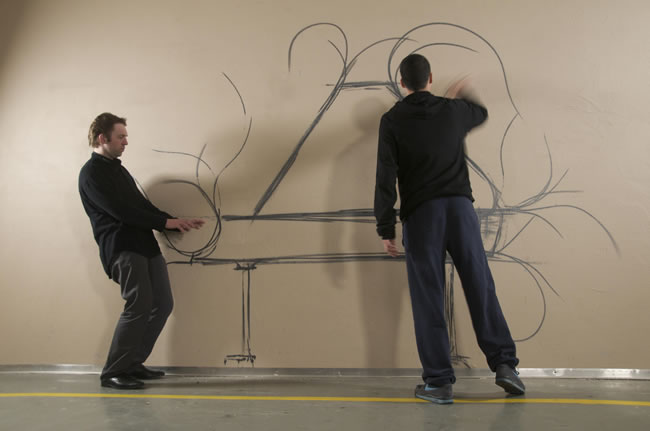
© NRK photographer Tore Zakariassen
Children's play
What is exactly the ‘childish’ element in Andsnes’s recital program? It also
contains Robert Schumann’s Kinderszenen (visually ‘accompanied’ by Rhode’s
Kid
Candle) and Mussorgsky’s unfinished Memories of childhood (1. Nurse and I and 2.
First punishment: Nurse shuts me in a dark room).
Andsnes explained in one of the program notes that Mussorgsky’s narrative in
Pictures at an Exhibition has always made him think of the gallery visitor as
an innocent, rather naive soul (perhaps even a child) marching in to see the
exhibition, in complete ignorance of what he will encounter. Robin Rhode’s
children animations were some of the first pieces of his art Andsnes saw, and
the inventive playfulness impressed him. When they worked on Pictures Reframed
it struck him that the entire program of the evening could have a childlike
spirit. He wanted to include Schumann’s Kinderszenen, Mussorgsky’s From Memories
of Childhood (only two movements exist), and Thomas Larcher’s new piano cycle
What becomes, a piece being partly composed in collaboration with Robin, who
created two new ‘children-animations’ to be shown together with the second and
last movement of the piece.
But it is not all children's play. Far from it. Rhode: “In the Pictures, in No
2, Gnomus (Gnome), which immediately follows the Pictures at an Exhibition’s
first Promenade, we observe a white theater stage, where tangled piano wires
fall from the ceiling to begin an abstract ballet. The wires become reminiscent
of anthropomorphic line drawings, three dimensional drawn studies of the body in
space. This stage-piece is inspired by Tchaikovsky’s ballet of The Nutcracker.
The forms within this ballet embody both an abstract as well as an
anthropomorphic quality that relates specifically to Gnomus, the original sketch
by Hartmann of a gnome waddling on bow legs. For Wire Ballet, I was interested
in highlighting a more playful element .”
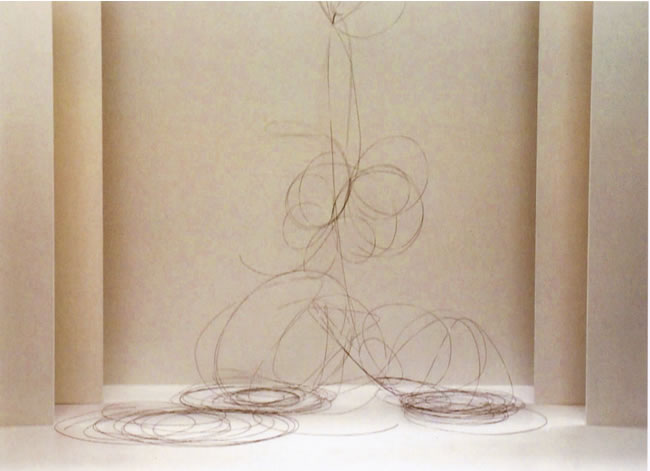
© Robin Rhode: Gnomus. Wire Ballet. 2009 (video frame, excerpt)
However, there is much more to be explained. So let's follow Rhode’s own program
notes from here. “In Promenade 3 the ‘Kadet’ stumbles within his geometric
surroundings, almost as if he is drunk. Mussorgsky’s own alcohol abuse surfaced
in his youth already whilst serving in the army. The visual accompaniment in
this Promenade alters the frame as if it is depicting the ‘Kadet’ from an aerial
perspective: "The visual device alters our perception of space, as if – being
guided by the character – the ‘Kadet’ is stumbling, searching for his reality,
while rejecting because he is intoxicated.” The audience may not be obliged to
think about all of this, but there is a lot to ponder about nevertheless!
No 4. Il Vecchio Castello. The Old Castle. 2009
The video depicts a forest in the shape of a pentagon. The shape refers to
architectural diagrams and models - I was specifically looking at the pentagonal
shape of the Castle of Good Hope situated in Cape Town, South Africa. The Cape
Castle was designed in the 1660’s by the colonialists as a mechanism to prevent
attack from any geographical side.
As time passes in the animation, we see metallic spheres begin to appear amongst
the trees as if a humanised construction challenges the natural landscape. The
pentagonal forest begins to shift outwardly in the shape of a five-pointed star.
In many of Hartmann’s architectural drawings he adorned the sketches with human
figures to indicate scale. In his painting of an old castle in Italy Hartmann
suggests the size of the building with the figure of a troubadour singing in a
serenade-like manner. The interesting depiction of the troubadour extends beyond
the notion of architecture vs man, but also towards a poetical fiction and
rhetoric that is inherent with troubadour songs, poems, and music.
This visual accompaniment uses the star-shaped forest to evoke the five
extremities of the human body - the head, two arms, two legs - and relates to
the human figure of the troubadour. The metallic spheres denote man’s existence
within nature and the tension arising from this given state.”
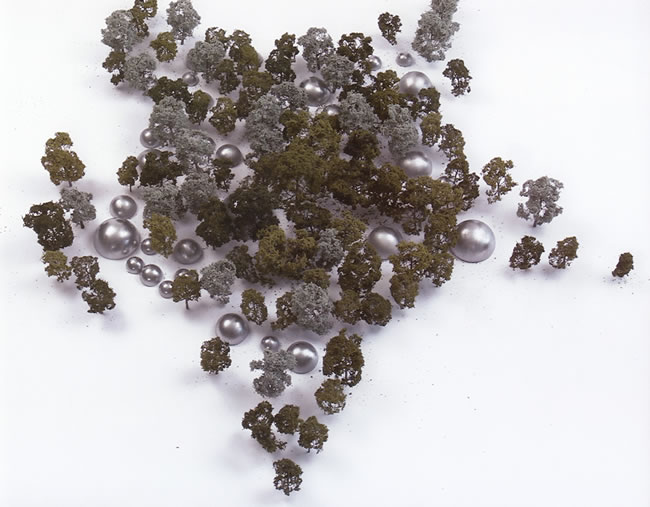
© Robin Rhode: Medieval Castle. 2009 (video frame, excerpt)
No 5. Promenade 3. 2008/09
This Promenade movement appears vigorous and confident while the recurrent
character of the Promenades, the ‘Kadet’, is assailed by a cloud of diamond
shapes that begin to overwhelm him. Slowly the geometric forms subside like a
tidal wave, allowing the character to grasp out and almost control the nature of
these abstract shapes.
This shape relates to a rhombus, a geometric form defined by the Greek
mathematician Euclid, ‘The father of Geometry’, as something that ‘spins’. In
the end the character, or ‘Kadet’, grasps a corner of the rhombus as if to make
sense of his fictional world.
No 6. Tuileries (Children's quarrel after playing). Tuileries Garden. Kite.
2008/09
Hartmann painted a watercolor of the famous gardens of Paris and enriched it by
including a group of quarrelling children. The geometric shape - the rhombus -
in the visual component appears again, this time as a window that references the
shape of a kite, almost passing through a path of trees as if being guided by a
breeze.
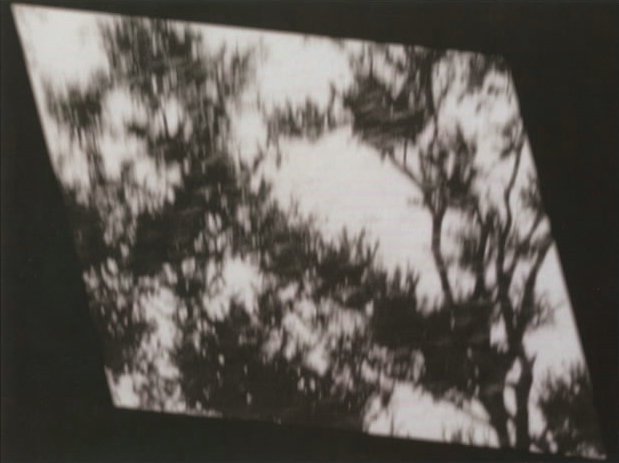
© Robin Rhode: Tuileries. Kite. 2008/09 (video frame, excerpt)
No 7. Bydło. Old Station.
2007/09
Bydło is a Polish word meaning ‘cattle’. Hartmann spent a month in the Polish
town of Sandomir. Whilst on this trip the artist sketched many ghetto scenes and
happenings. Hartmann was deeply conscious of society’s social struggle.
Therefore ‘Bydło’, the ox cart, could also be seen as a symbol for the poverty
and suffering of the people of Sandomir.
The visual accompaniment is a black and white film (transferred to video)
depicting the surrounding area of a train station. The metal fence with its
barbed wire, the dried grass blowing in the wind, a black bag caught on wire
fencing, all depict a social decay frozen within a single location. The train
also has a strong significance to South Africa’s dark political past. Masses of
people from rural areas suffering under the constraints of Apartheid Laws
travelled long distances into the cities for employment in the surrounding gold
mines. The train and Bydło share a common symbol.
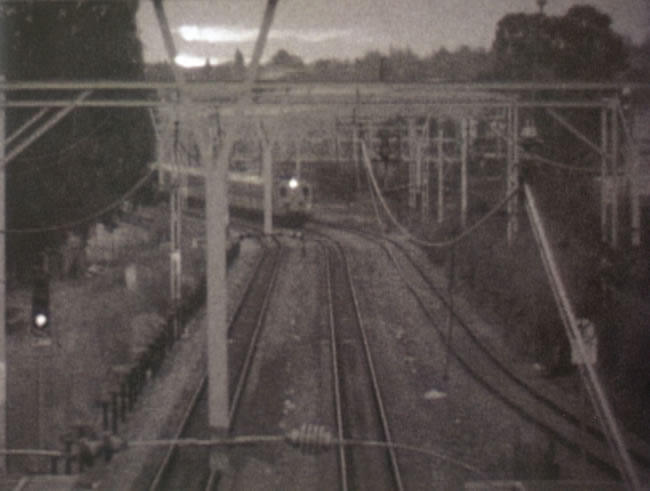
© Robin Rhode: Bydlo. Old Station. 2007/09 (video frame,
excerpt)
The image of the train arriving and then departing from the station without
anyone disembarking becomes a powerful metaphor for loss. As within European
history, when filmed in grainy monochrome footage the train relates specifically
to the persecution of the Jews during the Second World War. Millions of people
were taken by train to death camps and this visual accompaniment becomes a
reminder of the dark struggle for forgiveness that still informs our present
history.
No 8. Promenade 4. Apparatus. 2009
This visual animation depicts a table in the form of a drawing apparatus used by
artists and architects in the 16th century. The function of the apparatus is to
place an object or still life on one side of the table; a grid or graph paper is
placed on the other half on which to draw. Using the string grid situated in the
centre of the table the artist is able to view through and scale the subject by
using the string grid as an optic scaling mechanism.
In this Promenade the artist begins to draw at first a rhombus or diamond shape
on his paper. While engaging with the drawn outline the rhombus appears as a
three-dimensional form on the other side of the string grid. The object thus
functions as an extension of the artist’s imagination: reality appears first as
fiction. The rhombus then projects itself metaphysically into space while the
artist balances a triangle on the apparatus. This activity functions as a
mechanism to deny gravity as the artist’s spheres begin to elevate into space,
almost mimicking the movement and projection of the drawn rhombus.
Question: “Why is the rhombus a shape that is very present in this sequence and
in Promenade and Kite? Rhode: “The interest in the rhombus shape extends beyond
the geometric but also towards the diamond form and its meaning. A diamond
possesses unique physical properties. As one of the strongest and valuable
minerals, it also inherits properties relating to light refraction.
In the visual component accompanying Promenade 4 we see a geometrician drawing
the outline of a rhombus, a homage to the Greek mathematician Euclid and his
definition of the rhombus as a spinning top, ‘to turn round and round’. This
concept of a cycle or revolution allows for a new re-evaluation of Viktor
Hartmann’s work both as artist and engineer and his invested interest in
societies pushed to the brink of the margins.”
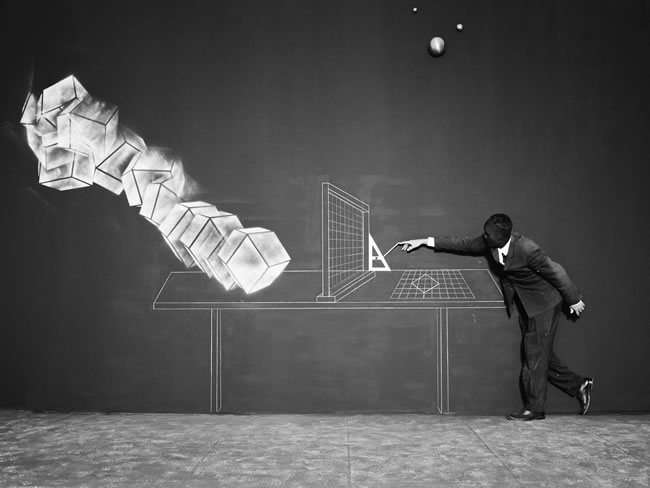
© Robin Rhode: Promenade 4. Apparatus. 2009 (video frame, excerpt)
No 9. Ballet of the unhatched Chicks. Trilbi. 2009
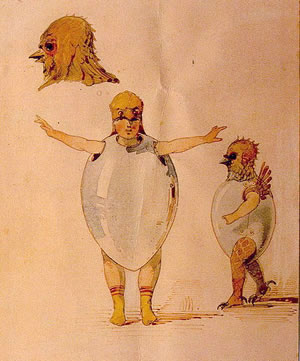
Viktor Hartmann: sketch of children in
chicken eggshell costumes
Hartmann’s sketch is that of children in chicken eggshell costumes for the
Russian ballet ‘Trilbi’. The visual accompaniment to this movement begins with a
child formally introducing a compass into the picture frame. The frame, a white
positive space, functions as a dance floor or stage. This introduction between
child and mathematical instrument appears as if partnered in a choreographic
dance. The compass is then set free by the child and, with its two legs moving
briskly across the white surface, it leaves outlined arc-like traces as if
embodying the spirit of a ballerina.
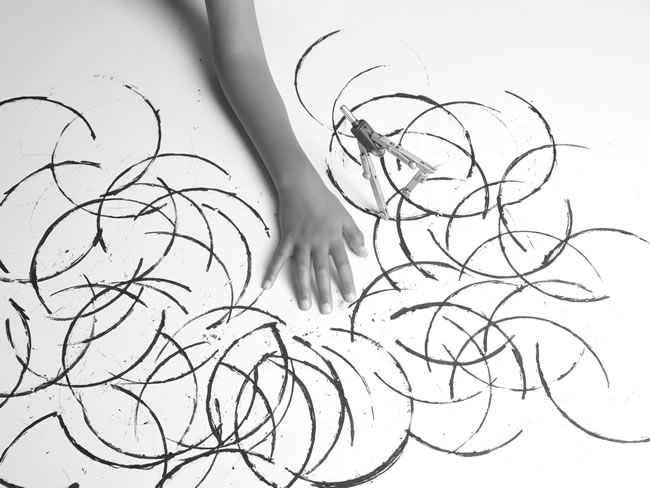
© Robin Rhode: Ballet of the unhatched Chicks. Trilbi. 2009 (video frame,
excerpt)
No 10. Goldenberg and Schmüyle. Bank symbols. 2009
Mussorgsky’s movement is referred to as ‘Samuel Goldenberg and Schmüyle’. The
music is descriptive of one of Hartmann’s drawings from the Polish town of
Sandomir. Here Hartmann again refers to the economic and social differences of
that time, between the rich Jew and the other, a dirt-poor beggar. It’s a
scenario depicting the noble vs tragic. Mussorgsky’s picture (both drawings were
his own property) carries this emotion very clearly into the music with the
exaggerated self-importance of the rich man and the apprehensive, timid beggar.
The visual accompaniment consists of a graphic black and white animation
depicting symbols taken from banks around the world. Here the bank symbols are
rendered superfluous as they morph from one symbol into the next. The formal
property of each symbol functions as an optic device. Its graphic nature
symbolizes a split second narrative that becomes frozen on the retina of the
eye. These symbols begin to represent our economic climate in a way that is both
abstract and relative, inclusive and exclusive.

© Robin Rhode: Goldenberg and Schmüyle. Bank symbols. 2009 (video frame,
excerpt)
No 11. Promenade 5. Kadet. (part 3). 2009
We see the ‘Kadet; character reappear, leaning on a wall that is at the same
time the ground, stumbling as if in a drunken state. With difficulty he manages
to balance himself onto the cubes under his feet, that in one moment become his
ground or promenade while in the next vanish, thus leaving the ‘Kadet’ perplexed
in his current state.
This visual component relates directly to Mussorgsky, himself an abuser of
alcohol, walking awkwardly towards the next picture in the exhibition.
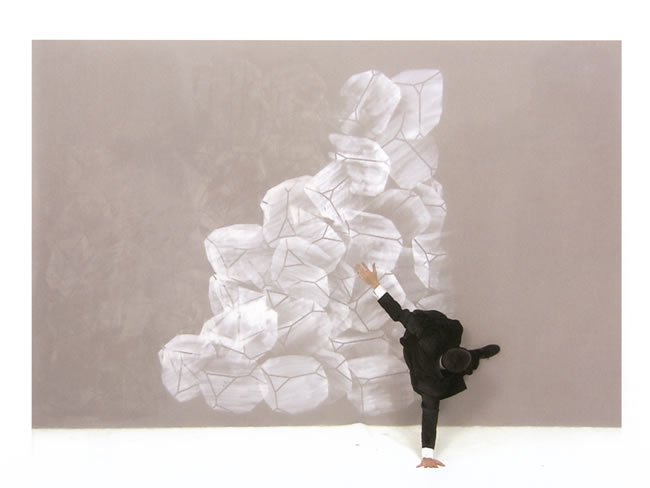
© Robin Rhode: Promenade 5. Kadet (part 3). 2009 (video frame, excerpt)
No 12. The Marketplace in Limoges. Chalk Piano. 2009
Hartmann painted more than 150 watercolors in Limoges. These paintings
celebrated the cathedral, others depicted picturesque scenes of women in the
marketplace quarrelling. It was this scene that inspired Mussorgsky’s movement.
The Chalk Piano visual component uses this movement as a breakaway from
Hartmann’s pictures, exploring the possibility of the piano as an instrument
that could compose a picture (in this case with chalk) if your imagination
allows it to. A row of chalk is lined up in the form of the piano keys. As the
fingers of the pianist begin to touch the chalk the pieces shift across the
blackened space creating starburst lines. The creation of these lines mimics the
fast paced rhythm of Mussorgsky’s movement while the pianist struggles to
maintain the fast tempo. The chalk keys rotate on the black surface creating a
white trace, a remnant of the sound evoked by the keys when touched by the
finger of the pianist. This haphazard routine creates tension between visual and
audio, a conflict which highlights the true source of Hartmann’s image.
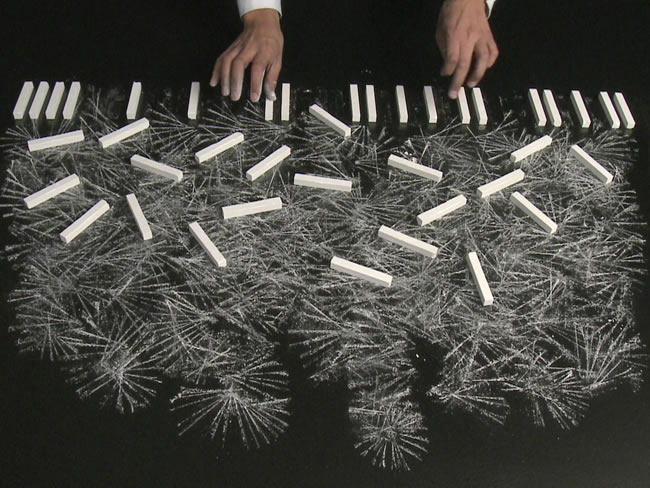
© Robin Rhode: Limoges - Le Marché. Chalk Piano. 2009 (video frame, excerpt)
No 13. Catacombae - con Mortuis in Lingua Mortua. Ink Strikes. 2009
Hartmann’s painting depicts him inspecting the Paris catacombs with a fellow
architect. Mussorgsky's music for this section is a restatement of the Promenade
theme. Mussorgsky added the following in Russian: »A Latin text: 'with the dead
in a dead language'. Well may it be in Latin! The creative spirit of the
departed Hartmann leads me to the skulls, calls me close to them, and the skulls
glow softly from within.«
The visual component is white abstract ink that splatters across a black space.
The painted action denotes a clear emotive rupture when the white mark is thrown
into the black void before it slowly disappears. An emotive moment becomes
shortlived, ephemeral.
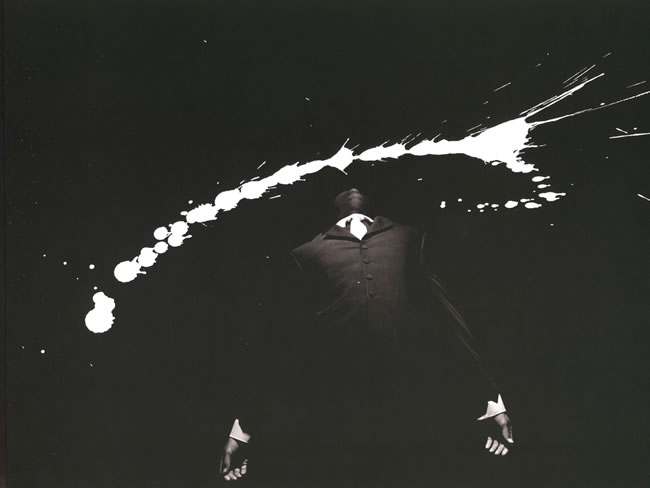
© Robin Rhode:Catacombae - con Mortuis in Lingua Mortua. Ink Strikes. 2009
(video frame, excerpt)
When the Promenade theme recurs under the title Con Mortuis in Lingua Mortua a
character in shadow silhouette is seen standing inside the picture. The
character symbolically relates to Hartmann, re-appearing in a dream amongst
splashes of ink strikes. The white ink and ghost become Hartmann with lantern in
hand generating light into the bowels of the catacombs.
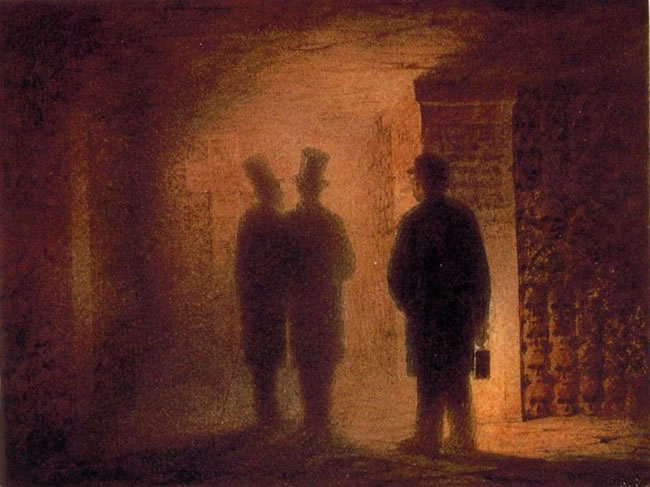
Viktor Hartmann: Catacombs
No 14. The Hut on Fowl's Legs. Baba-Yaga. 2009
According to Russian folklore, Baba-Yaga refers to a witchlike character who
dwells in a wooden house which stands on hen’s legs.
Hartmann had designed a clock in the shape of Baba-Yaga’s wooden hut standing on
chicken feet. Mussorgsky’s movement however relates more to Baba-Yaga and her
flying through the air rather than the actual clock designed by Hartmann.
For the visual accompaniment I used printed fabrics used by Southern African
witch doctors, known as sangomas, who practice a form of traditional healing.
They perform a holistic and symbolic form of healing, embedded in the beliefs of
their culture that ancestors in the afterlife guide and protect the living.
Sangomas are called to heal, and through them ancestors from the spirit world
can give instruction and advice to heal illness, social disharmony and spiritual
difficulties. In many cases a ritual sacrifice of an animal is performed,
usually a chicken. The spilling of this blood is meant to seal the bond between
witch doctor and the spiritual ancestors. The colors represented in the visual
component - black, white and red - are the sacred colors of sangomas in Africa.
The color white represents spiritual love, purity and virginity. Black
represents sorrow, despair, death, marriage and regeneration. Red represents
physical love, strong emotion, anger and heartache. The color blue embodies the
holistic state of the sky.
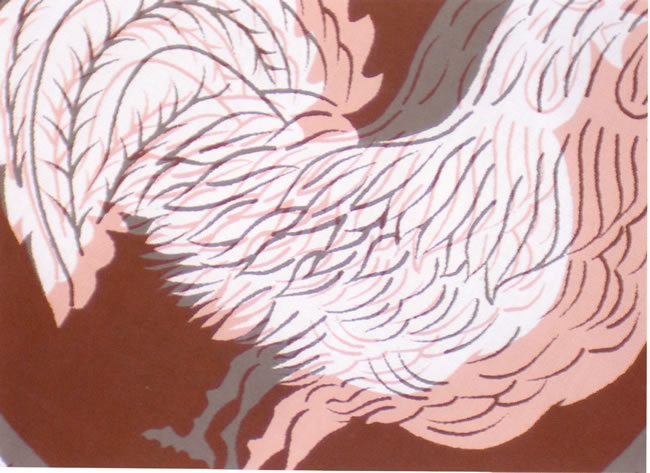
© Robin Rhode: The Hut on Fowl's Legs. Baba-Yaga. 2009 (video frame, excerpt)
These three colors, white, red and black, also refer to a Russian fairytale
‘Vasilissa the Beautiful’, collected by Alexander Afanasyev. In the fairytale
Vasilissa is sent to the house of Baba-Yaga to collect light. During her time at
the house she discovers three riders who pass by the house of Baba-Yaga. The
first rider in the color white represents Day, the red rider the Sun, and the
black the Night.
The visual component essentializes the meaning of Baba-Yaga in a formalistic
sense, thus beginning to touch on aspects of the spiritual world and its meaning
in contemporary society.
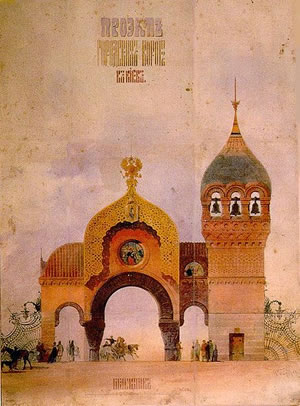
Viktor Hartmann: Draft for the city gate of Kiev
No 15. Great Gate of Kiev. Drowning Piano. 2009
Mussorgsky’s ceremonial movement ‘The Great Gate of Kiev’ was inspired by an
architectural drawing by Hartmann for the city gate of Kiev, and provides us
with a striking example of Russian imperial censorship exercised during this
time. According to contemporary accounts, a competition was announced to
commemorate the date April 4th 1866. What the censors withheld was that, on that
day, the Czar narrowly escaped an attempted assassination. Hartmann’s design -
an arch resting on two columns with the intention of sinking to the ground or
even collapsing - could be seen as a contemporary critique on the abuse of power
exercised by Russia’s Imperialists and the City Council of Kiev’s commemoration
for a monument.
The visual component titled ‘Drowning Piano’ functions as a powerful motif
evoked by Mussorgsky’s processional movement. Here we see the piano being
submerged in water, slowly drowning as water cascades onto the piano keys, then
later into the piano. The relentless flow of the water into the grand piano acts
as a metaphor of purging history. Once totally submerged the piano becomes a
kind of lost treasure beneath the ocean. The piano as object becomes an
antiquity of our time that at first has been hidden and then finally is
discovered before our eyes.
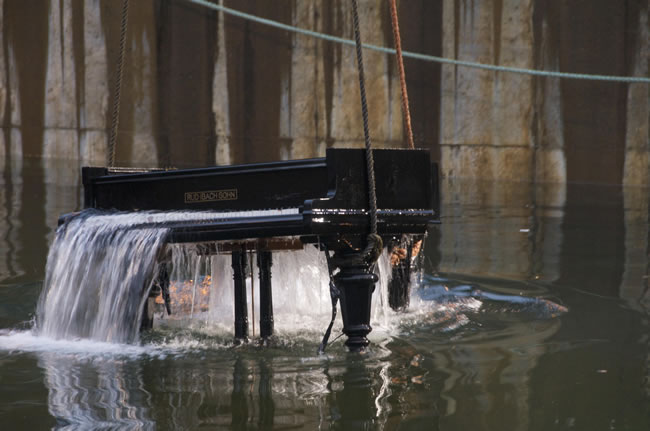
Opening the floodgates © NRK photographer Tore Zakariassen
Grand Finale
It was Rhode who came up with the idea of ‘murdering’ the grand piano in the
Picture’s last episode. To Andsnes's great astonishment, if not horror. It took
many talks between the two of them, but at the end Rhode could persuade Andsnes
‘to do it.’ Which meant in the hard reality of life that Rhode had to deliver
himself in March to the very cold water near Bergen in Norway to do the
underwater filming. It happened to be a very painful experience for him:
“Whenever I went underwater it felt as if nails were being hammered into my
face. It was absolutely unbearable.”
That last episode begins with the grand piano neatly positioned and anchored on
the (still dry) floor of a dry dock. The workers are looking from the dock’s
railing high above at the rusty metal catacomb below, where Andsnes packed in a
yellow wind jack is playing the piano as if he is on a warm and intimate podium.
But the dock does not keep dry for long. When the floodgates are opened the
water almost violently gushes in. It gradually rises from the piano wheels up to
the strings, until it reaches the instrument’s interior. The whirling water
flood keeps rising, and all the while Andsnes is hammering out those fortissimo
notes that symbolize the Great Gate of Kiev. The final stage of the drowning
process is introduced by the piano lid which closes spontaneously when attacked
by so much water. The still impressively looking concert grand gradually
disappears under the water surface. What remains is Rhode’s green colored
underwater filming, with the grand still firmly anchored on the floor of the
flooded basin. Andsnes found this drowning scene a gorgeous image, as he on his turn showed
that he had made a big sacrifice for this project by giving up the piano.
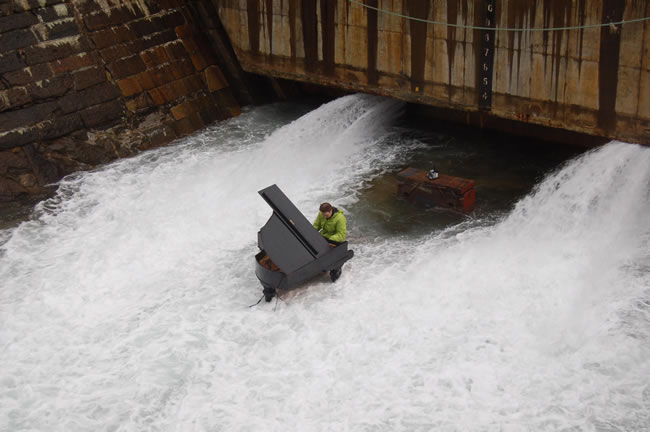
Opening the floodgates © NRK photographer Tore Zakariassen
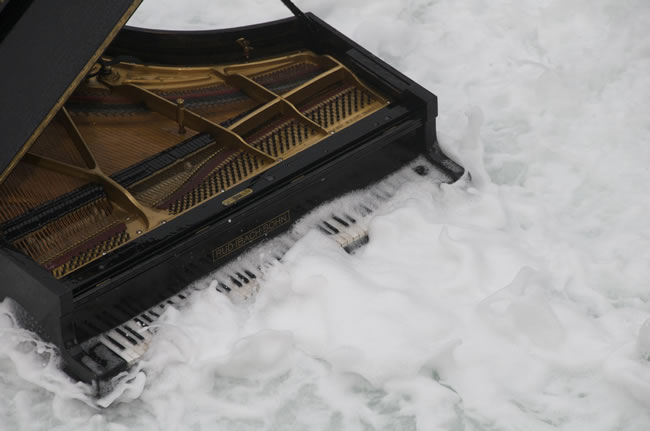
Opening the floodgates © NRK photographer Tore Zakariassen
Thomas Larcher: What becomes
According to the Austrian composer Thomas Larcher (1963) his composition What
becomes (commissioned by ECHO and the third work on Andsnes's program, just
preceding Pictures), is a piece in five movements for unprepared piano (or at
least only slightly prepared), because it is presented in a program without
intermission. In his view it would have been awkward if Mussorgsky’s Pictures
had to be played on an instrument which had become out of tune while being
prepared!
Why emphasizing on 'unprepared piano'? Larcher: “One could say that it is very
natural to write for a ‘natural’ piano. Yes, maybe, but for me this had not been
natural for many years. Exploring new things and sounds sometimes also has to do
with not wanting to face the status quo, hiding oneself in a so-called future.
In many of my earlier pieces I had fled into preparing the piano, wanting to
avoid hearing the natural piano sound, which I knew too well and with which I
had lived for forty years. I had always found it extremely difficult to say
something personal, maybe even new with this sound. But this time I had to face
the piano as such and try to make something interesting.”
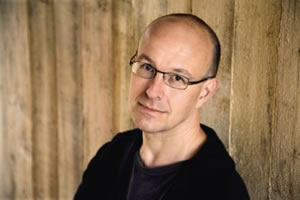
Thomas Larcher (1963)
Larcher started the work by composing its second movement, Parabolic Bikes,
first. It refers to an older Rhode animation on the one hand and to the jazz
player Lennie Larcher on the other. The line with which the movement begins
comprises many sub-lines and rhythmic models. This is why the line is divided
between the left and the right hand very carefully. In the course of the piece
this voice-leading becomes even more important and evident, the tempo gradually
slows down, the atmosphere gets more and more melancholic.
He added the introduction, Wertfrei, a flugelhorn melody, exploring the sound in
the piano with the aid of the pedal, one of the inventions that made the piano a
piano; and a whole world opens up in the instrument’s intestines.
Larcher: “I was uncertain how to go on, until I heard Andsnes playing
Mussorgsky's Pictures. This magnificent, daring, precise and radical piece gave
me enormous inspiration to use my insrtument and simply invent, invent and
invent...”
“Very simply, I could see that with my first part (Wertfrei) I had also created
a kind of 'promenade', and I could go on then, with another promenade and after
that with what I call 'a big scherzo', or as Leif Ove has called it, a 'scherzo
diabolique'.”
“This movement is the heart of the piece, I wanted to create a complex,
energetic, not to say aggressive piece with ordinary major/minor chords:
observing my own pieces I can very clearly see a tendency to write very quiet,
subtle tonal passages on the one hand and very motoric, loud and fast atonal
passages on the other - and I wanted to break through this cliché. I could do
this (and at the same time I couldn't), as the 'trio' (Don't step on the
Regenwurm) is of course one of those slow, beautiful things. The reprise (Schisma)
adds the element of the lines (as in Parabolic Bikes, but very much transformed)
to the chords and this causes the piece to burst apart.”
This Scherzo movement is not accompanied by animations but in a way is extending
the animation: here the conflict, the drama and the horror of Rhode's
animations, is pointed by making it musically explicit: Larcher had to shout it
out.
A further promenade (Isaac, referring to the renaissance composer) leads to the
end of the piece (Paper Planes) where the subtle playing inside the piano and on
the keyboard reminds us of the beginning.
European premiere
After six performances in the US and Canada (the work was premiered in New York
on November 13, followed by performances in North Carolina, Washington, Houston
and Calgary), the Brussels audience got the honor of the European premiere on
November 24. In a fully packed house (Center for Fine Arts, Heny Le Bœf Hall)
the lights had been carefully dimmed, with just a a few dimmed spotlights
directed to the keyboard. The stage itself was almost gloomily kept in the dark,
with Rhode’s six graphically printed large panels orbiting the stage. Yet,
without any musical sound and without any moving image, the atmosphere in the
hall was intriguing, if not somewhat gloomy. Some scenes reminded me of the
recitals by the Russian pianist Sviatoslav Richter, his figure hardly visible,
with only his face and the keyboard just dimly illuminated..
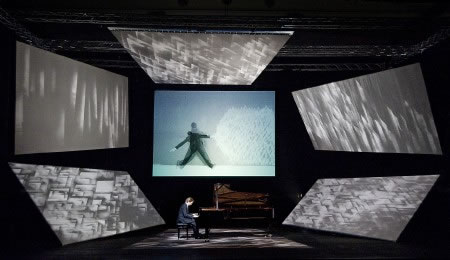
Andsnes performing Pictures Reframed at the Risør Chamber Music Festival (June
2009). Here, the rostrum is - compared to Brussels - much better illuminated
I had already watched the video on the EMI DVD and although I was quite
impressed by Rhode's imaginary graphic art work, it was Andsnes's playing that
overshadowed each and all. But here, in Brussels, it would be a more or less
three-dimensional multimedia display which could unleash a tremendous visionary
energy even superseding my wildest expectations. It could easily happen that
what I was going to see would be paramount, with dear Andsnes being overthrown
by Rhode's busy video images.
But the big surprise was finally mine: Andsnes played so magnificently that the
music ran its own supreme course. Andsnes's playing was a marvel: illuminating,
razor-sharp, the phrases sensitively shaped, almost improvisatory at times, with
an adamantine strength that created new worlds of sound and vision. Andsnes's
playing was on the scale of Sviatoslav Richter, with that sheer combination of
blazing technique and superb poetic and structural insight, prompting most
beautifully shaped cascades, as they seemed to emerge out of the sky. This
interpretative genius with his masterly control of dynamics rewarded his
audience with a far-fetched musical journey in a most ravishing setting of tone
colors. An important contributing factor was the he hall's warm acoustic, which
allowed for the luminous sonorities to materialize with great power and zest.
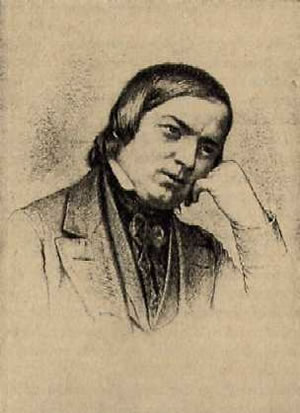
Robert Schumann (1810-1856)
We got a second-to-none performance of Mussorgsky's Pictures and we got no less
of Schumann's Kinderszenen, which equalled my one and only favorite in terms of
sheer magic: Radu Lupu's, with Martha Argerich running very, very close. This
was all about affection and transparency, delicacies and poetry.
With so many aurally ravishing beauties reaching my ears I forgot most about
Rhode's poignant and in some ways even daunting, mainly black-and-white video,
leaving me primarily with Andsnes's stunning achievement. Those five panels in
pensive shades of gray and the central video projection screen in the middle did
not only create Andsnes's 'working space' for his gorgeous interpretations, but
the overall dark setting also offered the audience great moments of
concentration or repose.
Andsnes gave Larcher's What becomes its premiere performance in New York on
November 13, and it was - as far as I have heard - well received in Lincoln Center's fully packed Alice Tully Hall. Well, it is a rather tumultuous and
virulent piece of about twenty minutes filled with postmodern phrases and
harmonies, ranging from Schubert to Copland and from the Renaissance to Cage.
Yes, Cage, because the pianist is expected to shorten the strings by hand, to
change pitch and to add some scratching sounds here and there. The brilliant
piece needs a frenetic performance to take off, but who could expect anything
else under the hands of the virtuoso Andsnes?
The loud yelling and whistles after the performance in Brussels might one
associate with the presence of a very enthusiastic young generation, but the
traditional applauding wave was no less loud and clear. Both artists had to
return five times before the public went to the exits at last.
The next morning, at the breakfast table, Rhode had his reservations
nevertheless: "Yes, we got lots of applause, but I must say that outside the
building I heard remarks I would rather not have heard at all. I don't even want
to repeat them here, in front of you. Frankly speaking, the reception overall in
the US was mixed, but what I heard here... Sorry." I gave him some comfort: "You
know, Robin, any object of art stands on its own, has its own unique identity,
and no one can take that away. Just assume that it reflects in quite a positive
way in thousands of people seeing or hearing it." He gave me a big smile and
walked away to join Andsnes, the salmon and the orange juice.
Both the DVD and CD released by EMI Classics offer such lifelike sounds and
images that you might at least applaud after this incredible performance. As in
Brussels the Steinway Grand at the Risør Chamber Festival (a quickly sold out
annual artistic joint venture in which Andsnes actively participates) was, like
in Brussels, a most lucky shot again, with a very impressive sound resonance and
a huge variety of instrumental colors.
Postludium
Time will tell if Rhode's video project will stand the test of time. The chances
are there that it will quickly wear itself out, and that another new project
needs to be developed to nourish audiences all over the world with new visionary
refreshments. We shall also have to wait and see if a new generation will change
its course from pop concerts to classical music concerts, albeit on their own
terms. Or maybe both, with or without video projections to partner the music. I
am not that optimistic because one thing is absolutely sure: musical education
must start on elementary school level and this is just not the case. In the
meantime we should be more than grateful that we have Leif Ove Andsnes playing
the stars from the heavens and that we can highly enjoy his performances, with
or without Robin Rhode's imaginative and magnificent art work.
The DVD and CD release
EMI CLassics:
Pictures Reframed | Deluxe Edition (individually numbered):
152-page book of full-color art prints by conceptual artist Robin Rhode.
CD: Studio recording by Leif Ove Andsnes of Mussorgsky's Pictures at an
Exhibition, From Memories of Childhood (Nurse and I | First Punishment: Nurse
Shuts Me in a Dark Room | Rêverie | Near the Southern Shore of the Crimea,
1880), and Schumann's Kinderszenen.
|
|
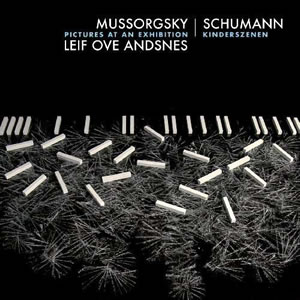 |
This article also appears in
opusklassiek.nl
DVD: includes a 50-minute ‘making-of’ documentary Leif Ove Andsnes - Reframed
(recorded June 2008-June 2009 and produced by NRK - Norwegian Broadcasting
Corporation) chronicling the journey of Leif Ove Andsnes and Robin Rhode in
creating Pictures Reframed as well as a full length performance of the work.
A single audio CD release of this Leif Ove Andsnes recording is also available. Digital album to include audio commentary by Leif Ove Andsnes and Robin Rhode as
well as full length performance footage.
Pictures Reframed was recorded at the Risør Chamber Music Festival, June 2009
(DVD) and Henry Wood Hall, London, December and June 2009 (CD).
More information is available from these web sites:
www.picturesreframed.com
www.emiclassics.com
www.andsnes.com
www.youtube.com
© Aart van der Wal, November 26, 2009

